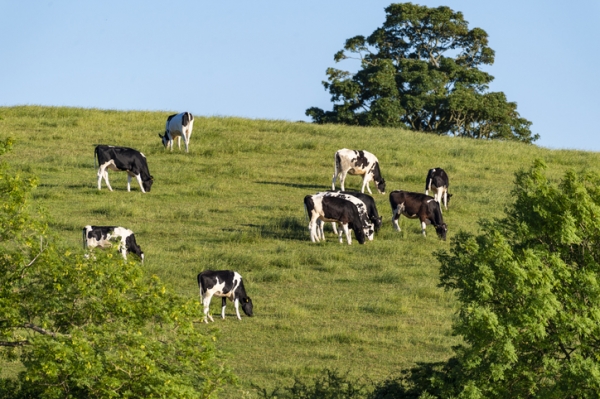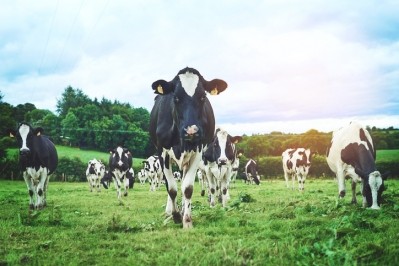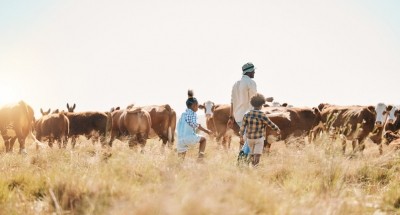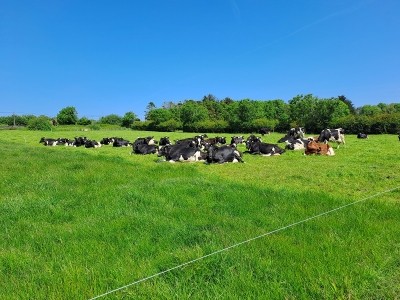Review: Quantifying and mitigating methane emissions from pastoral dairy systems is challenging

Further research is needed to identify protracted strategies for reducing CH4 emissions that do not require constant feeding, argue the researchers, who are based at the USDA-Agricultural Research Service, and the Department of Agriculture, Nutrition and Food Systems at the University of New Hampshire.
The term ‘grazing system’ has different meanings worldwide, which may affect greenhouse gas (GHG) emissions and practical mitigation strategies due to widely varying feeding and management systems, said the authors.
“Regions such as New Zealand and Ireland have grazing systems where there is limited use of feeds other than fresh forage. South America and North Australia have tropical and subtropical grazing systems with forages that differ from many other parts of the world. The US has a wide range of systems from no-grain grazing systems to hybrid systems that feed higher amounts of stored forages and concentrates.”
Their paper looks to summarize potential strategies to mitigate methane emissions in grazing dairy systems, including practical applications and whole-system considerations.

Breeding, vaccination approaches
Low-input, long-acting strategies are needed, according to the experts.
Breeding animals for reduced CH4 emissions shows promise, as long as the purchase of such animals is not cost-prohibitive and animal production is not impaired, they said.
“Genetic selection of animals with lower enteric CH4 emissions would be advantageous as the reduction would be permanent and additive.”
Low-CH4-emitting sheep have been shown to reduce CH4 emissions by 10% to 15% after three generations without adversely affecting production, said the authors. “Animals expressing the low-CH4 trait are expected to be commercially available to sheep producers in New Zealand in the next few years (Reisinger et al., 2018).”
They noted that cattle show similar potential for breeding strategies (Teagasc, 2021), but progress is slower due to greater research costs and longer generation intervals than sheep.
“Research on proxies such as milk constituents or ruminal microbiota profile may enable less expensive and rapid identification of low-CH4-emitting dairy cattle,” they added.
Development of vaccines that target methanogen reduction would be especially useful on grazing farms where cows cannot be supplemented continuously, said the reviewers.
“However, commercial availability may still be five to ten years away. Although all major components of a vaccine chain have been demonstrated, including genome sequencing of methanogens and the production of antibodies by host animals that suppress pure cultures of methanogens in vitro, the efficacy, immune memory, and cost effectiveness have yet to be fully investigated,” they stated, citing work by Reisinger et al., 2021.
The authors also pointed out that further research on slow-release delivery technologies would be beneficial, technologies that provide a constant supply of CH4-inhibiting activity in the rumen for cows not supplemented continuously.
The review includes a summary of the effect of various concentrate levels and types on enteric CH4 emissions in dairy cows grazing different forage sources.
Other management strategies to mitigate enteric methane emissions and applicability to pastoral dairy systems were also evaluated.
Condensed tannins
The researchers outlined how condensed tannins (CT), or proanthocyanidins, are secondary polyphenolic compounds naturally produced by some legumes, forbs, and other forages and grains as a defensive mechanism against herbivory.
And they highlighted that the feeding of CT-containing legumes to ruminants has shown a direct inhibitory effect on ruminal archaea and protozoa, which, they reported, indirectly depresses ruminal fiber digestibility, and may also reduce CH4 emissions.
Chemical inhibitors
While supplements or compounds found naturally in some forages and concentrates can help mitigate CH4, chemical inhibitors such as 3-nitroxypropanol (3-NOP) may have high potential to suppress enteric CH4 emissions, they noted, referencing studies by Beauchemin et al., 2020 and Hristov et al. 2022.
Those studies reported a consistent reduction in enteric CH4 production, yield, and intensity without a negative effect on production performance of confined dairy cows in a metaanalysis. However, they also maintain the efficacy of 3-NOP seems to decrease over time and it has a very short-lived active period in the rumen.
For these reasons, the US review team argues that 3-NOP may not be practical for grazing-based dairies unless the chemical inhibitor can be administered through delivery methods such as a long-lasting bolus or its long-term efficacy improves.

Lipids
Lipids have been shown to decrease CH4 emissions by up to 60% in grazing beef and dairy cattle (Vargas et al., 2022) and they also increase energy intake in dairy cattle, said the reviewers.
However, they noted that lipid supplementation can be costly, is not practical for grazing ruminants that are not otherwise supplemented and can also negatively affect ruminal fiber digestibility with highly variable results (Beauchemin et al., 2020), particularly when total lipids exceed 5% to 6% of the diet dry matter (DM).
Nitrate supplementation
Nitrate supplementation may mitigate enteric CH4 emissions in lactating dairy cows in confinement, but data are limited under grazing conditions, said the team.
Studies conducted in South Africa with grazing dairy cows supplemented with varying levels of nitrate (up to 15.2 g/kg of dry matter intake (DMI)) showed marginal effects on enteric CH4 emissions using both warm-season (van Wyngaard et al., 2018c) and cool-season (van Wyngaard et al., 2019) grasses.
“High-quality forages often contain crude protein (CP) levels well in excess of nutrient needs for lactating dairy cows. Addition of nitrate to the diet could cause excessive urinary nitrogen, which in turn could increase nitrogen leaching and nitrous oxide emissions (Marshall et al., 2021)," the authors cautioned.
Seaweed
Algal-based feeds such as seaweed have gained interest as an additive in ruminant diets to reduce enteric CH4 emissions while improving animal health, they remarked.
“However, there is limited information on the impact of seaweed on CH4 suppression in grazing dairy cows.”
One study in which dairy cows were given 113g per day of a supplement derived from brown seaweed, Ascophyllum nodosum, showed showed a significant diet × period interaction; CH4 production decreased by 10.9% during the first period, but no change was detected in the remaining two periods (Antaya et al., 2019), they commented.
The concentrations of crude protein and neutral detergent fiber ranged from 13.9% to 17.5% and 50.9% to 66%, respectively, in the cool-season legume-grass mix forage grazed by cows, with supplement DMI (partial TMR plus pelleted grain) averaging 49% of the total DMI in that study, thus not representing many other grazing systems worldwide, said the US experts.
“Overall, for algae-based feed to be adopted by dairy producers, enteric CH4 emissions must be substantially decreased without negatively affecting milk yield and milk composition. In addition, seaweed anti-methanogenic effects would need to persist over time, which depends on the stability of bioactive compounds and on how harvesting, processing, and seasonality affect their concentrations in algal tissues.”
Source: JDS Communications
Title: Enteric methane emissions in grazing dairy systems
Authors: KJ Soder, AF Brito








